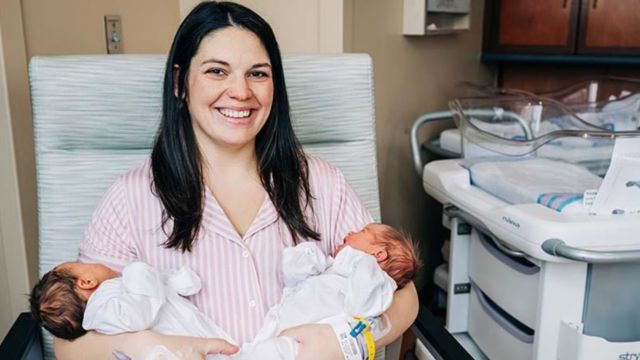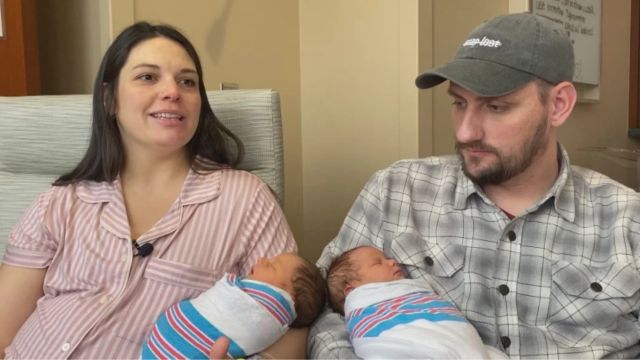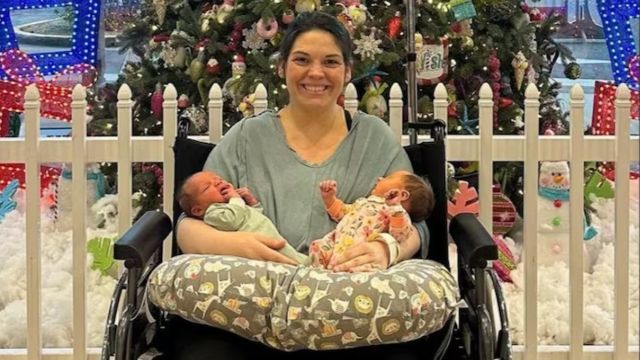Alabama Woman Welcomes ‘Miracle Twins’ in Extraordinary Birth with Double Uterus
Just in time to bring her twin children home for Christmas, 32-year-old Kelsey Hatcher gave birth to them after gaining notoriety for her “one-in-50-million” pregnancy.
Due to a rare disorder known as uterine didelphys, the Alabama woman possesses two uteruses. This disorder affects only approximately 0.3% of the population.
Hatcher was expecting her fourth child, and during this pregnancy, one of her twins was removed from each uterus. Approximately one in 50 million women will experience this kind of pregnancy, an OB/GYN at Houston’s Baylor College of Medicine told Scientific American.

Hatcher was expected to be inducted on December 19 at the University of Alabama at Birmingham Hospital, according to a press statement sent to Fox News Digital.
Hatcher gave birth to two girls, who arrived in the world on different days, after putting in 20 hours of labor in total.
Roxi’s birthday is December 19. December 20 is Rebel’s birthday.
“Never in our wildest dreams could we have planned a pregnancy and birth like this, but bringing our two healthy baby girls into this world safely was always the goal, and UAB helped us accomplish that,” Hatcher said in a press release.
“However, it seems fitting that they celebrated two birthdays. Both of them had their own “home,” and they now each have a distinct birth narrative.”
When Hatcher was seventeen, she first learned of her disease. Raelynn, age six, River, age four, and Rhemy, age two, were the products of “normal” pregnancies.
During Hatcher’s most recent pregnancy, an eight-week scan revealed that she was carrying twins in two distinct uteruses.

“All I could do was laugh,” Hatcher said in an interview with Fox News Digital before. “Since my spouse, Caleb, was missing from our appointment, I informed him right away. We just laughed together, him and me.”
Hatcher repeated how “rare and special” her case was, adding that her doctors were equally shocked. Shweta Patel, M.D., an assistant professor in the UAB Department of Obstetrics and Gynecology and Kelsey’s obstetrician, treated Hatcher during her third pregnancy as well as the most recent “miracle” pregnancy, which Patel described as a “true medical surprise.”
“I was aware that I would require more experience,” the physician stated in the news release. “Luckily, I was able to reach out to my UAB maternal-fetal medicine colleagues who specialize in high-risk obstetrics cases and unique pregnancies.”
Hatcher had a regular pregnancy, save for a few extra appointments. “At the end of the day, it was two babies in one belly at the same time — they just had different apartments.”
According to Richard O. Davis, M.D., a professor in the UAB Division of Maternal-Fetal Medicine, “pPretermor early birth is a high possibility in a typical twin pregnancy because the twins share one womb, which can limit the amount of space each has.”
Co-managing Hatcher’s pregnancy, Davis continued, “Kelsey’s babies had their own womb, sac, placenta, and umbilical cord, allowing them extra space to grow and develop.”
Hatcher gave birth to one baby in each uterus, but she also discharged two eggs that fertilized at the same time as ovulation, meeting the requirements for being considered fraternal twins.

In the release, Davis stated, “At the end of the day, it was two babies in one belly at the same time.” “They just had different apartments.”
The way the infants were delivered was the biggest unknown. According to Patel, although C-sections might be a “more controlled delivery option” in high-risk circumstances such as Hatcher’s, the doctors aimed to respect Hatcher’s desire for a safe and similar birth experience to that of her prior children.
Hatcher was induced at 39 weeks gestation when she failed to go into labor naturally. Two labor and delivery nurses were assigned to her to keep an eye on each uterus and baby.
“As my contractions began, they were not consistently together but were within a few seconds of each other,” Kelsey stated to UAB. “I also sensed several contractions on each side. One constant that moved from the left to the right on the monitor struck me.
On December 19, at 7:45 p.m., the baby called Roxi, who weighed 7 pounds, 7 ounces, was delivered vaginally. “There was a cheer from everyone in the room when the first baby was delivered, but there was another baby left,” Patel stated.
“Kelsey was essentially laboring in the left uterus while simultaneously undergoing the postpartum process in the right.” “After such a long and crazy journey, it meant the world to see both of my girls together for the first time.”
“She was having contractions with Baby B while breastfeeding Baby A.” The decision was taken to deliver Baby B, named Rebel, via C-section when the induction process took longer than the physicians had anticipated.
At 6:10 a.m. on December 20, Rebel was born weighing 7 pounds, 3.5 ounces. When Rebel was born, the nursing staff made arrangements for Roxi’s bassinet to be in the operating room.
“After such a long and crazy journey, it meant the world to see both of my girls together for the first time,” Hatcher stated.
